
The Senusiyya, Senussi or Sanusi are a Muslim political-religious Sufi order and clan in colonial Libya and the Sudan region founded in Mecca in 1837 by the Grand Sanussi, the Algerian Muhammad ibn Ali al-Sanusi. Sanusi was concerned with what he saw as both the decline of Islamic thought and spirituality and the weakening of Muslim political integrity.

The Battle of Omdurman was fought during the Anglo-Egyptian conquest of Sudan between a British–Egyptian expeditionary force commanded by British Commander-in-Chief (sirdar) major general Horatio Herbert Kitchener and a Sudanese army of the Mahdist State, led by Abdallahi ibn Muhammad, the successor to the self-proclaimed Mahdi, Muhammad Ahmad. The battle took place on 2 September 1898, at Kerreri, 11 kilometres (6.8 mi) north of Omdurman in Sudan.

Muhammad Ahmad bin Abdullah bin Fahal was a Sudanese religious and political leader, of Nubian ethnicity. In 1881, he claimed to be the Mahdi, and led a successful war against Ottoman-Egyptian military rule in Sudan and achieved a remarkable victory over the British, in the siege of Khartoum. He created a vast Islamic state extending from the Red Sea to Central Africa, and founded a movement that remained influential in Sudan a century later.
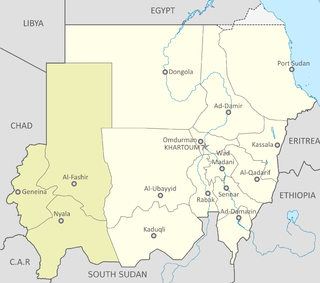
Darfur is a region of western Sudan. Dār is an Arabic word meaning "home [of]" – the region was named Dardaju while ruled by the Daju, who migrated from Meroë c. 350 AD, and it was renamed Dartunjur when the Tunjur ruled the area. Darfur was an independent sultanate for several hundred years until 1874, when it fell to the Sudanese warlord Rabih az-Zubayr. The region was later invaded and incorporated into Sudan by Anglo-Egyptian forces in 1916. As an administrative region, Darfur is divided into five federal states: Central Darfur, East Darfur, North Darfur, South Darfur and West Darfur. Because of the War in Darfur between Sudanese government forces and the indigenous population, the region has been in a state of humanitarian emergency and genocide since 2003. The factors include religious and ethnic rivalry, and the rivalry between farmers and herders.

Anglo-Egyptian Sudan was a condominium of the United Kingdom and Egypt in the Sudans region of northern Africa between 1899 and 1956, corresponding mostly to the territory of present-day South Sudan and the Sudan. Legally, sovereignty and administration were shared between both Egypt and the United Kingdom, but in practice the structure of the condominium ensured effective British control over Sudan, with Egypt having limited, local power influence in reality. In the meantime, Egypt itself fell under increasing British influence. Following the Egyptian Revolution of 1952, Egypt pushed for an end to the condominium, and the independence of Sudan. By agreement between Egypt and the United Kingdom in 1953, Sudan was granted independence as the Republic of the Sudan on 1 January 1956. In 2011, the south of Sudan itself became independent as the Republic of South Sudan.

Abdullah Ibn-Mohammed Al-Khalifa or Abdullah al-Khalifa or Abdallahi al-Khalifa, also known as "The Khalifa" was a Sudanese Ansar ruler who was one of the principal followers of Muhammad Ahmad. Ahmad claimed to be the Mahdi, building up a large following. After Ahmad's death, Abdullah Ibn-Mohammed took over the movement, adopting the title of Khalifat al-Mahdi. He attempted to create a kingdom, which led to widespread discontent, and his eventual defeat and death at the hands of the British and Egyptians.
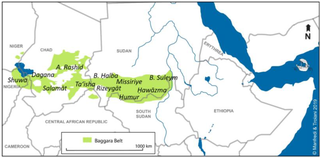
Ta'isha, or Ta'aisha, or Taaisha, one of a series of Arabic-speaking groups collectively called Baggara "cattle people", who live in Sudan, across southern Kordofan, Darfur, as well as Chad. The Ta'aisha tribal homeland is in the far southwest of Darfur, neighbouring to the east the Habbaniya, with whom they are closely related. The Ta'aisha rose to power when one of the members of their tribe, Abdallahi ibn Muhammad, later known as the Khalifa, became an early follower of Muhammad Ahmad, who would later become the Sudanese Mahdi. During the revolution, 'Abdallahi became the strongman of the movement and was designated as senior Khalifa by the Mahdi. Following the Mahdi's death in June 1885, the Khalifa 'Abdallahi ruled the Mahdist state until its destruction by an Anglo-Egyptian army. The Khalifa during his rule brought his tribe to Central Sudan and he went on to make extensive use of his relatives and other fellow Ta'a'isha as soldiers and administrators. Throughout the Mahdist period there was constant tension between the Ta'aisha leaders and the riverain Sudanese. Several Ta'aisha amirs who survived the Mahdiyya became prominent at the re-established Darfur Sultanate of Ali Dinar, one being Arabi Dafallah, who was appointed commander of the Equatorial province with its headquarters at Rejaf under the Khalifa's rule. Having been forced in 1897 to evacuate Equatoria by Belgians advancing from the Congo, he had made his way into southern Darfur where he faced Anglo-Egyptian forces and friendly tribes sent by Kitchener in pursuit of him. He then settled in the area of the present Central African Republic-Darfur border where he came into contact with encroaching French colonial power. After an unsuccessful attack on French outposts in the region he surrendered to Sultan 'Ali Dinar with his men and their arms in 1902, he subsequently lived in Al-Fashir and took part in many of the Sultan's military expeditions. Another one was 'Ali al-Sanusi, who was a Mahdist amir under Mahmud Ahmad in Atbara and fought at Karari after which he escaped to Darfur to be one of 'Ali Dinar's best generals. Under the British colonial rule, He was appointed Nazir of the Ta'aisha in Darfur and rendered valuable service to the new administration.

The Rizeigat, or Rizigat, or Rezeigat are a Muslim and Arab tribe of the nomadic Bedouin Baggara people in Sudan's Darfur region. The Rizeigat belong to the greater Baggara Arabs fraternity of Darfur and Kordofan and speak Chadic Arabic. They are primarily nomadic herders and their journeys are dependent upon the seasons of the year. They are a branch of the Juhayna group. They are divided into the Abbala (camel-herding) Rizeigat, who live in northern Darfur and Chad, and the Baggara who inhabit south-east Darfur. In turn they are divided into several large clans, notably the Mahamid, Mahariya and Nawaiba. The ecological differences between the north and south of Sudan allowed for two different types of nomadism to evolve: camel herders in the north and cattle herders in the south.

The Mahdist State, also known as Mahdist Sudan or the Sudanese Mahdiyya, was a state based on a religious and political movement launched in 1881 by Muhammad Ahmad bin Abdullah against the Khedivate of Egypt, which had ruled the Sudan since 1821. After four years of struggle, the Mahdist rebels overthrew the Ottoman-Egyptian administration and established their own "Islamic and national" government with its capital in Omdurman. Thus, from 1885 the Mahdist government maintained sovereignty and control over the Sudanese territories until its existence was terminated by the Anglo-Egyptian forces in 1898.
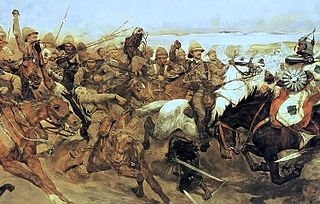
The Mahdist War was a war between the Mahdist Sudanese, led by Muhammad Ahmad bin Abdullah, who had proclaimed himself the "Mahdi" of Islam, and the forces of the Khedivate of Egypt, initially, and later the forces of Britain. Eighteen years of war resulted in the creation of Anglo-Egyptian Sudan (1899–1956), a de jure condominium of the British Empire and the Kingdom of Egypt in which Britain had de facto control over Sudan. The Sudanese launched several unsuccessful invasions of their neighbours, expanding the scale of the conflict to include not only Britain and Egypt but also the Italian Empire, the Congo Free State and the Ethiopian Empire.

The Sultanate of Darfur was a pre-colonial state in present-day Sudan. It existed from 1603 to 24 October 1874, when it fell to the Sudanese warlord Rabih az-Zubayr, and again from 1898 to 1916, when it was occupied by the British and the Egyptians and was integrated into Anglo-Egyptian Sudan. At its peak in the late 18th and early 19th century it stretched all the way from Darfur in the west to Kordofan and the western banks of the White Nile in the east, giving it the size of present-day Nigeria.
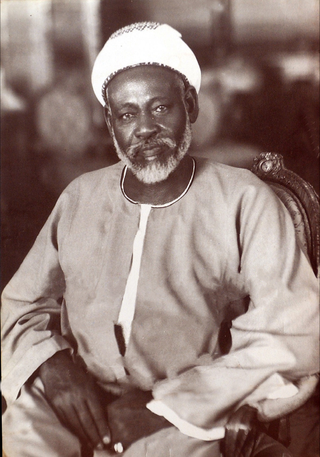
Sayyid Abd al-Rahman al-Mahdi, KBE was one of the leading religious and political figures during the colonial era in the Anglo-Egyptian Sudan (1898–1955), and continued to exert great authority as leader of the Neo-Mahdists after Sudan became independent. The British tried to exploit his influence over the Sudanese people while at the same time profoundly distrusting his motives. Throughout most of the colonial era of the Anglo-Egyptian Sudan the British saw Sayyid Abd al-Rahman al-Mahdi as important as a moderate leader of the Mahdists.
Sayyid Muhammad Sharif was one of the three Kalifas or lieutenants of Muhammad Ahmad (1844–1885), who styled himself the Mahdi, the others being Ali wad Hilu and Abdallahi ibn Muhammad. Muhammad Sharif was the son of Hamid Muhammad, first cousin of the Mahdi.

The Ansar is a Sufi religious movement in the Sudan whose followers are disciples of Muhammad Ahmad, a Sudanese religious leader based on Aba Island who proclaimed himself Mahdi on 29 June 1881. His followers won a series of victories against the Egyptians culminating in the capture of Khartoum in January 1885.

The Invasion of Darfur was the military invasion and occupation of the Sultanate of Darfur by the British Empire and the Sultanate of Egypt from 16 March to 6 November 1916. The sultan of Darfur, Ali Dinar, had been reinstated by the British after their victory in the Mahdist War but during the First World War he grew restive, refusing his customary tribute to the Sudanese government and showing partiality to the Ottoman Empire in 1915.
Karam Allāh Muḥammad Kurkusāwī was a Dongolāwī Mahdist emir (amīr). Born on the island of Kurkus, near Shendi, Karam Allāh worked with slave traders in the Baḥr al-Ghazāl in his youth. In 1882 he went to al-Ubaiyaḍ to enlist with the Mahdists.
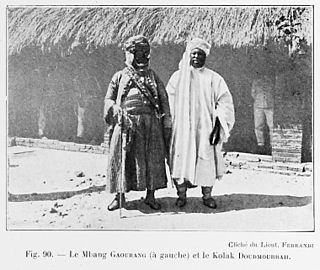
Muhammad Salih bin Yusuf, known as Dud Murra or Dudmurrah, was the last independent ruler, or kolak, of the Wadai Empire. He allied with the Sanusi, powerful traders of the eastern Sahara, and with the Sultan of Darfur to resist French aggression in the eastern Sahel, but was defeated. His sultanate was incorporated in the French military territory of Chad.

Frank Miller Lupton, or Lupton Bey, was a British sailor who served as an administrator in the Egyptian Sudan. He was governor of Bahr el Ghazal province in 1881 at the start of the Mahdist War. Cut off from supplies and reinforcements, he had to surrender the province in 1884. After an initial period of freedom he was enchained for ten months. He was freed but struggled to make a living, his health deteriorated and he died in poverty. He had married a local woman who survived him, as did their two daughters.

The Mahdi's tomb or qubba is located in Omdurman, Sudan. It was the burial place of Muhammad Ahmad, the leader of an Islamic revolt against Turco-Egyptian Sudan in the late 19th century.


















